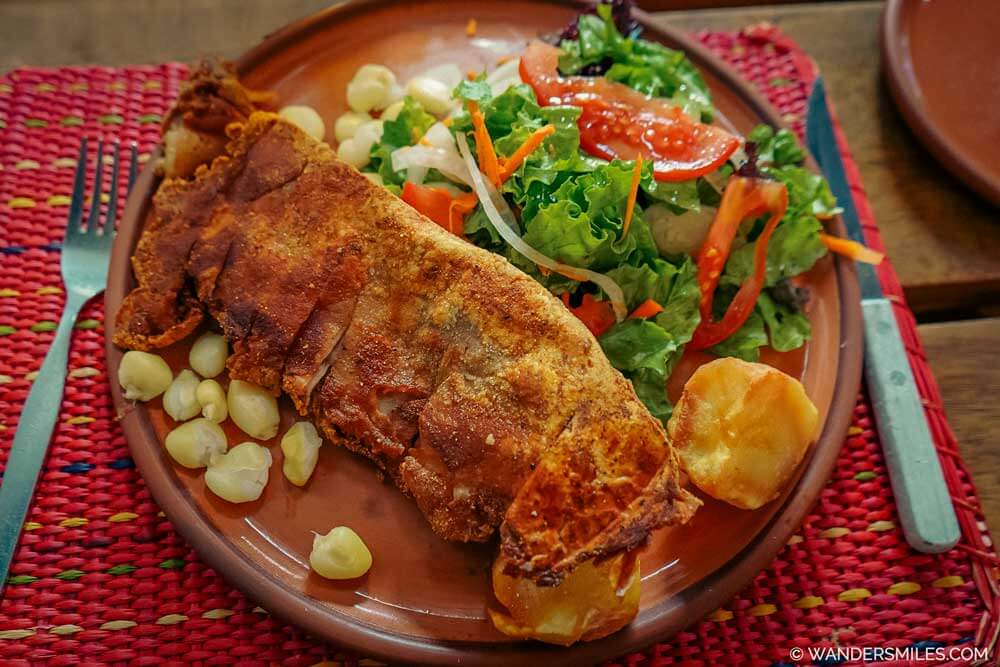Peru is renowned as a top gastronomic destination, celebrated for its rich cultural fusions, regional specialities, and typical Peruvian dishes dating back to Inca times. On your next trip to Peru, whether you’re sampling from street vendors or dining in world-class restaurants, Peruvian cuisine promises to be a journey in itself.
From coastal ceviche to hearty Andean stews, let’s explore the mouthwatering dishes that embody Peruvian food and culinary traditions. With an ‘eat like the locals’ approach, I savoured the best foods of Peru during my two-month journey across the country.
Hope you find this guide to typical Peruvian foods useful for your next South American adventure.

Typical Peruvian Appetisers
Causa (cold potato dish)
Peru is known as the land of many potatoes, and in fact, grows around 4,000 varieties. It stands to reason that the most traditional Peruvian dish, Causa, features layers of creamy mashed yellow potatoes mixed with lime, oil, and ají amarillo.
Causa is typically filled with tuna, chicken, or seafood salad, and garnished with avocado, hard-boiled eggs, and olives. Served cold, causa is a hearty appetiser that shows off Peru’s diverse ingredients. I had a fantastic time at Las Qolqas Eco Resort exploring my culinary creativity by making causa with the chef.


Sopa a la Criolla (Creole Soup)
Sopa a la Criolla, a traditional Peruvian soup, blends Spanish and indigenous culinary influences. Originating in colonial times, it’s made with small chunks of beef or chicken, noodles, potatoes, tomatoes, and ají panca (“Panka” chilli pepper). Seasoned with garlic, onions, and oregano, this hearty soup often includes milk and a poached egg for added richness.


Papas a la Huancaina (Potatoes in Spicy Cheese Sauce)
Papas a la Huancaína originates from Huancayo and is traditionally served as a classic Peruvian appetiser. The dish is simple and satisfying, made of boiled potatoes topped with a creamy sauce made from queso fresco (cheese), ají amarillo (Peruvian hot chilli pepper), garlic, and evaporated milk.
One of the most Peruvian dishes, you can find this served across the board from high-end restaurants right down to the markets found in most towns and cities. Whilst Papas a la Huancaína is commonly garnished with olives and hard-boiled eggs. I am not a fan of olives hence they are missing from the photo when I indulged in Mercado Central de San Pedro in Cusco.


Typical Peruvian Dishes
Chaufa (Rice Dish)
Arroz de Chaufa showcases the country’s Chinese culinary influence. Similar to the Chaufa in Ecuadorian food, its history in Peru dates back to the late 19th and early 20th centuries, when Chinese immigrants came to work in plantations and railroads.
This Peruvian-Chinese fusion of tasty fried rice combines cooked rice with soy sauce, scallions, eggs, and a mix of meats like chicken, beef, or shrimp. Enhanced with ginger and garlic, it’s often served with a drizzle of sesame oil. It’s a simple and seriously tasty typical Peruvian food on a plate!


Ceviche
Ceviche, Peru’s national dish, is a refreshing seafood delicacy made with raw fish marinated in freshly squeezed lime or bitter orange juice, mixed with sliced onions, chilli peppers, and seasoning. The acidity of the citrus cures the fish, giving it a zingy flavour. Often served with sides like sweet potatoes, corn, and lettuce, it’s a culinary staple.
Ceviche in Peru varies by region and ingredients. Coastal regions favour traditional fish ceviche with lime, chilli, and onions. whereas in the Amazon, ceviche might be made with river fish and exotic fruits. The traditional Peruvian ceviche in the highlands of the Andes such as Cusco is commonly served with trout (trucha).


Chicharrón de pescado
Chicharrón de Pescado is quite simply bite-sized pieces of fish marinated in lime juice and spices, then coated in flour and deep-fried until crispy. This popular Peruvian dish is often served with lime wedges, salsa criolla, and fried yucca or plantains, it highlights Peru’s love for seafood.


Rocoto relleno (Stuffed Peppers)
Rocoto Relleno, originating from Arequipa is a traditional dish made with spicy rocoto peppers stuffed with a savoury mix of ground beef, onions, garlic, olives, and hard-boiled eggs, often seasoned with cumin and oregano. The stuffed peppers are baked with a cheese (queso fresco) topping and often served with Pastel de Papas (potato pie) on the side to ensure you have filled every last corner of your stomach. Every mouthful was welcome, believe me!


Cuy (Guinea Pig)
In Peru, cuy (guinea pig) is a staple meat raised in many Andean households, with an estimated 65 million consumed annually. Its history dates back to the 12th century AD, during the Inca rule. The importance of cuy is highlighted in Cusco’s Catedral Basilica, where a 1753 replica of Da Vinci’s Last Supper hangs, featuring a platter of this typical Peruvian dish.
Traditionally, the meat is baked or spit-roasted whole, often with herbs, and served with ají chilli sauce. Cuy has a mild flavour with a hint of game tasting similar to rabbit or wild fowl. Guinea pigs were my first pet as a child so it took me over four months on my Ecuador and Peru slow travel adventure to pluck up the courage to give it a go.


Alpaca
In Peru, the adorable alpaca provides high-quality fibre for clothing and blankets, and its meat is a traditional Andean staple, prized for its lean and tender qualities. Historically consumed by the Incas, alpaca is cooked in various dishes such as alpaca steaks, grilled or marinated with herbs and spices, and alpaca stew (seco de alpaca), slow-cooked with potatoes, carrots, and ají peppers.
Pollo a la Plancha
Pollo a la Plancha emphasises the simple, fresh ingredients found in traditional Peruvian home cooking. The chicken is marinated in lime juice, garlic, cumin, and ají panca, then grilled to perfection. Served with sides like rice, salad, or potatoes, this dish is one of the typical Peruvian foods that you can’t avoid on your travels.


Aji de Gallina (Creamy Chicken)
Ají de Gallina is created with shredded chicken in a creamy, mildly spicy sauce made from ají amarillo peppers, walnuts, cheese, garlic, and milk. This sauce is thickened with de-crusted white bread or crackers. Typically Ají de Gallina is served over rice and accompanied by boiled potatoes and black olives.
Ají de Gallina wasn’t my favourite out of the typical Peruvian dishes I tried on my travels. It may have been a bad recipe or just not my bag. there must be a reason why this hearty plate is a popular classic food in Peru.
Lomo Saltado
Lomo Saltado is another Peruvian dish that blends Chinese and Peruvian culinary influences. Originating from the fusion of Chinese stir-fry techniques with local ingredients, it features strips of beef marinated in soy sauce and vinegar, stir-fried with tomatoes, onions, and ají amarillo peppers. Served over French fries and accompanied by rice, this flavourful dish got a big thumbs up from me.
|| RELATED ARTICLE: From Pisco Sour to Chicha Morado, read about traditional Peruvian drinks you can’t miss when you travel to Peru.
Tiraditos
Tiraditos is a dish influenced by Japanese immigrants and has evolved in Peru. The thinly sliced raw fish, similar to sashimi, is drizzled with a piquant sauce made from lime juice, ají amarillo (yellow chilli), and a touch of garlic. Unlike ceviche, tiraditos are sauced just before serving, preserving the fish’s delicate texture.


Adobo (Pork Stew)
Adobo, a savoury pork stew from Arequipa, dates back to pre-Hispanic times. Traditionally enjoyed during festivities, it comprises marinated pork cooked with chicha de jora (corn beer), garlic, onions, and spices like cumin and ají panca. Slow-cooked until tender, this aromatic stew is often served with bread, perfect for mopping up the last of the juices.


Typical Peruvian Desserts
Tres Leches (three milk bread)
Tres Leches was first made in Nicaragua and has made its way across Latin America. Now a popular dessert in Peru, this indulgent cake is soaked in a mixture of three milks: evaporated milk, condensed milk, and heavy cream. The spongy cake base absorbs the sweet, creamy mixture, creating a moist texture. The cake is sometimes topped with whipped cream and cinnamon.
For a Peruvian twist on Tres Leches, the cake may include local fruit juices like lucuma or maracuya (passion fruit). I enjoyed the flavour, though I’m not a fan of soggy cake.


Churros
Churros have their roots in Spanish cuisine but the Peruvian churros have an added twist. These crispy, golden pastries are made from a choux pastry, a simple dough of flour, water, butter, and salt, piped into long strips and deep-fried until crunchy.
In Peru, churros are often dusted with sugar and served with rich, creamy dulce de leche or chocolate for dipping. You can’t visit Peru without indulging in the yummy churros!


Picarones (Sweet Potato Donuts)
Picarones are a popular Peruvian treat that dates back to colonial times. These sweet potato and squash donuts are deep-fried until crispy and golden. Served drizzled with a sweet syrup made from chancaca (raw sugar cane syrup), they’re a delicious blend of sweet, crunchy, and soft, perfect for satisfying any sweet tooth.


Food Tours for Typical Peruvian Foods
The best way to experience typical Peruvian foods is by experiencing the divine restaurants and tasty street food, To get the lowdown from a local, check out food tours on your travels.
Best Food Tours in Lima
Best Food Tours in Cusco
Best Food Tours in Arequipa
PIN for Typical Peruvian Foods
Disclosure: This post contains affiliate links, which means I may receive a small commission if you click a link and purchase something that I’ve recommended. It comes at no cost to you. Thank you for your support.
Source link




